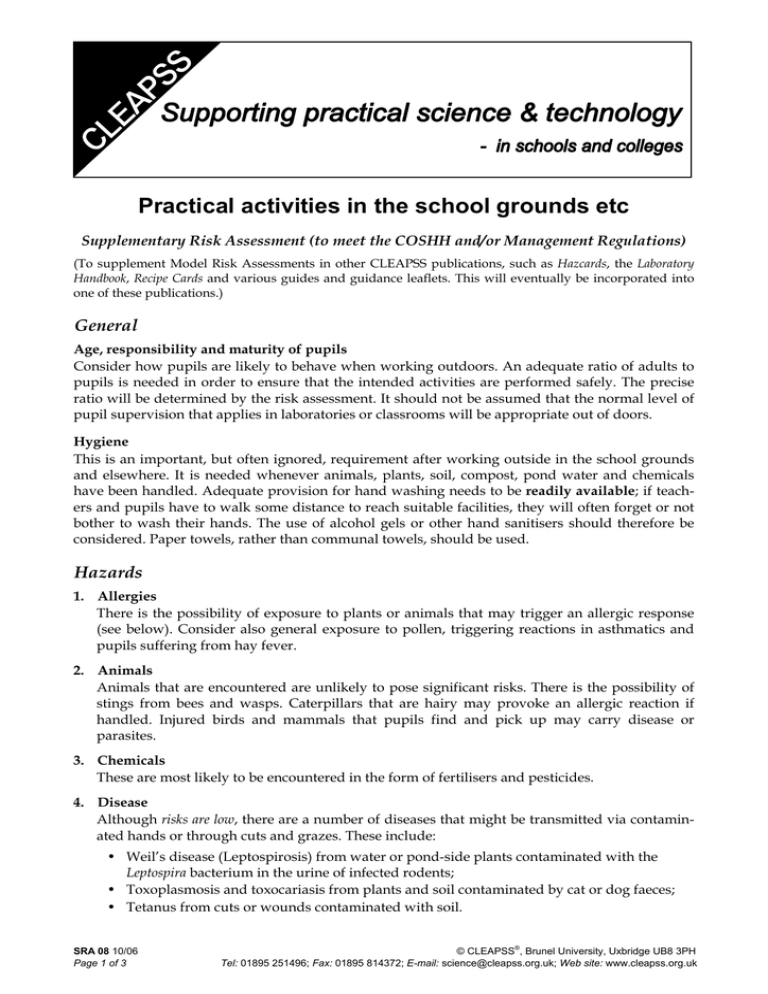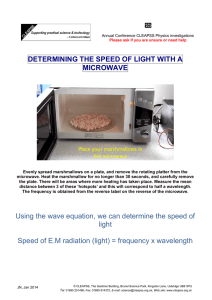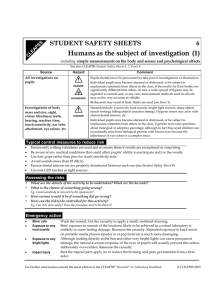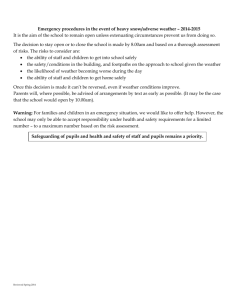SRA 08 School grounds
advertisement

Practical activities in the school grounds etc Supplementary Risk Assessment (to meet the COSHH and/or Management Regulations) (To supplement Model Risk Assessments in other CLEAPSS publications, such as Hazcards, the Laboratory Handbook, Recipe Cards and various guides and guidance leaflets. This will eventually be incorporated into one of these publications.) General Age, responsibility and maturity of pupils Consider how pupils are likely to behave when working outdoors. An adequate ratio of adults to pupils is needed in order to ensure that the intended activities are performed safely. The precise ratio will be determined by the risk assessment. It should not be assumed that the normal level of pupil supervision that applies in laboratories or classrooms will be appropriate out of doors. Hygiene This is an important, but often ignored, requirement after working outside in the school grounds and elsewhere. It is needed whenever animals, plants, soil, compost, pond water and chemicals have been handled. Adequate provision for hand washing needs to be readily available; if teachers and pupils have to walk some distance to reach suitable facilities, they will often forget or not bother to wash their hands. The use of alcohol gels or other hand sanitisers should therefore be considered. Paper towels, rather than communal towels, should be used. Hazards 1. Allergies There is the possibility of exposure to plants or animals that may trigger an allergic response (see below). Consider also general exposure to pollen, triggering reactions in asthmatics and pupils suffering from hay fever. 2. Animals Animals that are encountered are unlikely to pose significant risks. There is the possibility of stings from bees and wasps. Caterpillars that are hairy may provoke an allergic reaction if handled. Injured birds and mammals that pupils find and pick up may carry disease or parasites. 3. Chemicals These are most likely to be encountered in the form of fertilisers and pesticides. 4. Disease Although risks are low, there are a number of diseases that might be transmitted via contaminated hands or through cuts and grazes. These include: • Weil’s disease (Leptospirosis) from water or pond-side plants contaminated with the Leptospira bacterium in the urine of infected rodents; • Toxoplasmosis and toxocariasis from plants and soil contaminated by cat or dog faeces; • Tetanus from cuts or wounds contaminated with soil. SRA 08 10/06 Page 1 of 3 ® © CLEAPSS , Brunel University, Uxbridge UB8 3PH Tel: 01895 251496; Fax: 01895 814372; E-mail: science@cleapss.org.uk; Web site: www.cleapss.org.uk Pupils may eat sweets and snacks with dirty hands. 5. Plants and fungi There are several poisonous flowering plants, as well as mushrooms and toadstools, that may be found in the school grounds and other outdoor environments. For many poisonous species, all parts of the plant are toxic. In others, the poison is concentrated only in specific organs such as bulbs, fruits or leaves. Some species are not so much poisonous as irritant or allergenic when their leaves and stems are handled or sap is smeared onto the skin. In some cases, eg, parsnip, such contact requires exposure to ultra-violet light before a reaction is produced (photo-sensitisation). Handling the bulbs of several species may cause dermatitis. Some plants with thorns etc may cause injuries to the skin and eyes. 6. Sunburn Possibility of sunburn on unprotected skin on sunny, summer days, if exposed for more than 20-30 minutes. 7. Tools and equipment There may be risks of injury when using and carrying various gardening tools or equipment and heavy loads, eg, bags of soil. For each tool used and load carried, risks should be assessed for each person, pupil or adult. An assessment of the capability of individuals in handling a tool or lifting a load safely must take into account his or her age, maturity and fitness as well as the working environment (eg, slippery mud). Injuries may be more likely if inappropriate footwear is worn. 8. Hazards in the environment There may be unsafe items, for example, broken glass or discarded ‘tin’ cans and syringes/ hypodemic needles hidden in grass or soil which cause cuts if accidentally encountered. There may be other hazards such as building rubble, pot holes in the ground or other unsafe structures which could cause wounds or children to trip. Control measures 1. Allergies Be alert for the development of allergies and asthmatic attacks, which will be dealt with according to the school’s normal policy. 2. Animals Wash hands after coming into contact with any species. Bee or wasp stings, although painful, are not a major problem unless a pupil is already known to have an allergic reaction to such stings. Handle hairy caterpillars only with gloves. 3. Chemicals It is recommended that schools avoid the use of fertilisers and pesticides entirely by adopting organic gardening methods. If chemicals are used, this should be under close teacher supervision (or by teachers only), eye protection should be worn as appropriate, and the instructions on the labels of pesticides followed exactly. Pesticides that have been formulated for agricultural purposes must never be used by untrained personnel. 4. Disease Ensure that all hands are washed properly. With younger pupils, this should be seen to be done. Cuts and grazes on exposed skin must always be suitably covered. Look for (and remove hygienically) any animal faeces in the areas to be studied. Pupils should be dissuaded from eating snacks etc while working out of doors. SRA 08 10/06 Page 2 of 3 ® © CLEAPSS , Brunel University, Uxbridge UB8 3PH Tel: 01895 251496; Fax: 01895 814372; E-mail: science@cleapss.org.uk; Web site: www.cleapss.org.uk 5. Plants and fungi Risks of poisoning are minimal since serious ill effects are only likely if quantities of poisonous plants are consumed. Adequate supervision will prevent pupils eating suspect plants or fungi. Gloves should be worn when handling plants that may be irritant, allergenic or have thorns etc. Eye protection may also be required, for example, when clearing brambles. 6. Sunburn Control measures include the appropriate use of sun creams and encouraging the wearing of long-sleeve shirts and hats. Restrict the length of time of exposure. Stripping to the waist during strenuous work should be avoided. If arduous work is carried out for any length of time in the Sun, beware also of heat exhaustion. Ensure there is a sufficient supply of drinking water. 7. Tools and equipment It should not be assumed that people know how to lift loads or use a tool safely; simple training may be needed. Equipment to help carry heavy loads, eg, trucks and wheelbarrows, should be used. If manual handling cannot be avoided, several people may be needed to lift or carry an item. Avoid bending or twisting the back when carrying a heavy load. Powered tools and machinery must not be used by anyone who is insufficiently trained and knowledgeable to handle them safely. Tools and equipment must be suitable for their intended use; a tool designed for use by an adult may be quite inappropriate or the wrong size for a child to handle. Items purchased for domestic, d-i-y tasks or worn tools brought in from home may not be able to cope with the strains of heavy use in the school grounds. The correct tool must always be chosen for a particular task; improvisation can lead to accidents. Handles of spades, forks, rakes etc should be smooth and free from splinters. When digging or shovelling, back strain should be avoided by using leg muscles as much as possible; eg, pushing a shovel handle against thigh muscles, keeping the back straight. Pupils should wear sensible footwear when digging with spades and forks. There should be at least two handle-lengths’ distance between people who are digging etc, to prevent accidental body contact and injuries. Garden tools should not be left upright in the soil but should be laid safely on the ground with the blade or tines pointing downwards. Tools should be carried safely at their point of balance, held by the side and with the blade or tines pointing forward. Wearing gardening gloves will help to protect the skin from blisters etc when there is heavy use of spades, forks etc. Cuts and grazes on exposed skin must always be suitably covered. 8. Hazards in the environment The area in which children will be working should be surveyed in advance to identify any hazardous objects which should be removed and disposed of safely. Pot holes should be filled in and, for other unsafe structures which cannot be removed, they should be suitably identified with warning signs and children can be kept away from them. NOTE. See SRA 09 for using a school pond. SRA 08 10/06 Page 3 of 3 ® © CLEAPSS , Brunel University, Uxbridge UB8 3PH Tel: 01895 251496; Fax: 01895 814372; E-mail: science@cleapss.org.uk; Web site: www.cleapss.org.uk



